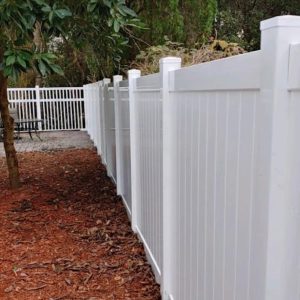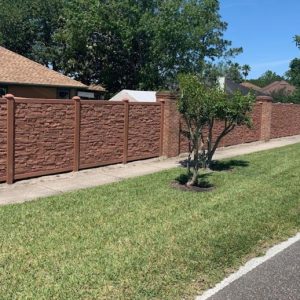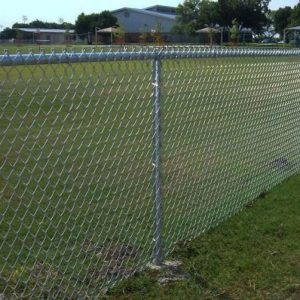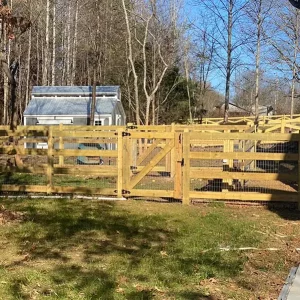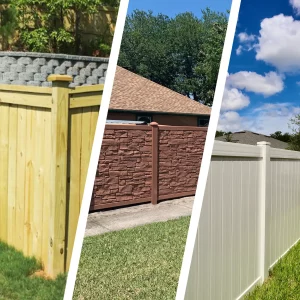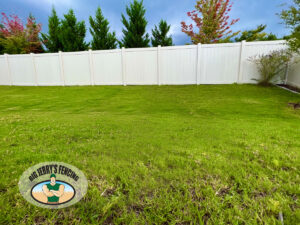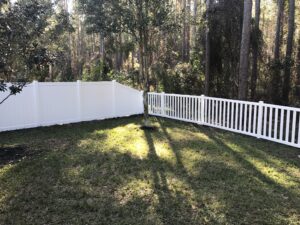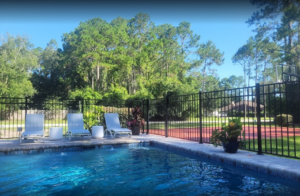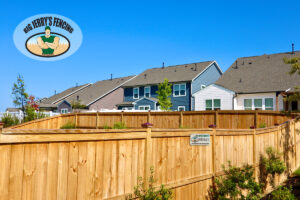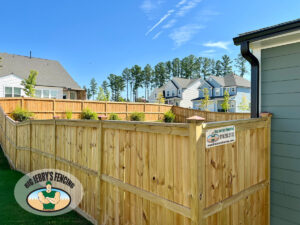Knowing how to build a fence starts with a good amount of preparation and planning. Fences can be made from wood, vinyl, metal, and composite materials. When planning a fence project for your home, many things need to be taken into consideration throughout the process. Continue reading below to learn more about the fence installation process.
Most homeowners prefer to have their fences professionally installed as opposed to DIY. If you’d prefer a professional build a fence on your property, contact your local Big Jerry’s Fencing for a free fence quote.
Planning for your fence
- Know your property boundaries: Get your property surveyed
Knowing where your property lines are located is an important part of owning a home, but it is particularly vital when installing a new fence. To avoid costly disputes with your neighbors, you will need to ensure the fence is built on your property and does not encroach on your neighbor’s land. You may be able to find your property line by visiting your local county recorder or assessor’s office. If you are uncertain of exactly where your property line is, you should contact a local property surveying company and request to have your property pins marked or flagged. It is a good practice to make your neighbors aware of an upcoming fence project to avoid confusion and potential delays.
- Learn local fence rules
Be sure to research and understand your local fence guidelines and restrictions. Most cities, townships, or counties have their fence rules posted online and are easily accessible to the general public. These rules often will dictate the height of the fence, the fence materials to be used, and where you can place the fence on the property. Many areas also require a building permit before building a fence. Not adhering to the local ordinances can result in fines and liens on your property. Building a fence is hard work and can be expensive, but even more so when you have to redo it a second time because you didn’t follow the appropriate guidelines, so make sure you build your fence right the first time.
- Measure your layout
Once you know where your property lines are located and what fence regulations impact your property, you are ready to measure your desired fence layout. Measure the perimeter of the fenced area to get the total linear footage, it is a good idea to work up a sketch and document the measurements for each respective fence line, as that could impact the materials you will need for your project. Determine where you want to locate your gates. Measure and document all gate sizes. Gates can be made from partial panels or by assembling the rails and pickets to blend with the rest of the fence, you can also purchase gate kits from many fence supply companies.
- Submit plans to your HOA
Many communities have a Homeowners Association, or HOA, that acts as a neighborhood governing body. These HOAs oftentimes have set guidelines for the exterior aesthetics of the homes within the community. These restrictions dictate what trees you can plant in your front yard and what type of fence you are allowed to have. Often, these guidelines will also tell you where the fence is allowed to be installed on the property if your neighborhood has an HOA in place, then you will likely need to submit a fence application to the architectural review committee. On average, this review and approval process occurs every 30 days, and approvals are usually sent out via email, or they will mail an approval letter to you. It is recommended to always wait for approval before building your new fence to prevent potentially costly discrepancies.
- Order Materials
If you are building a fence using pre-assembled panels, divide the linear footage of fencing by the panel length (in feet) of the style fence you selected. This will determine the total number of fence panels and posts you need. The remaining footage will require a partial panel. Add an additional post for each corner of the property to determine the total number of posts you need. Make sure to order your gate posts separately, most fence types require bigger, stronger, or otherwise reinforced posts for the hinge side of the gate.
Some fence styles have different posts to use in certain parts of the layout, such as corners and ends. Make sure you take this into account when ordering your fence materials. Don’t forget to order the extra items like post caps, concrete, and gate hardware.
- Call 811 before you dig
You should always request to have your underground utility lines located through 811 before installing your fence. 811 is a national call-before-you-dig service that will request to have your utility lines located and marked by your local utility companies or other locating services. It is important to note that the 811 ticket only covers your public utilities. This means your private lines, such as irrigation, will not be marked by 811. All lines marked by a locating service have a grace area of 2 feet to each side of the marking. That means the utility line could be anywhere within that 4-foot-wide path.
Building your fence
- Run a string line
First, start by running a string line parallel to the house. Then run perpendicular lines to complete the perimeter, crossing the string line at the corners of the property. If done properly, this will help ensure that your fence lines are straight and stay within the constraints of your property.
- Mark your corners & gates
Using spray paint, mark the locations of your corners and end posts. Your end posts will essentially be where the fence starts and ends. In most cases, this is somewhere on each side of your house. Spray paint parallel lines on the ground to indicate the gate placement. Gates are usually 4ft or 5ft wide, depending on need; if you don’t need the additional clearance, then it is recommended to go with 4ft wide to help prevent common gate problems such as leaning and sagging. This will also help minimize any sizeable gaps underneath the gate door.
- Dig your holes
You are now ready to start digging your fence post holes using a post hole digger or an auger. If you are digging through a concrete slab, a core drill or concrete breaker may be required.
How far apart should I set my fence posts?
The distance between each fence post depends on the fence material you use. You will want to dig the fence posts based on the width of the fence panels you use. Most wood fences are built in 8ft sections, while most vinyl and aluminum come in 6ft sections. Chain link fence posts are typically set about 10ft apart, while farm-style fences vary depending on style and application (usually between 8-12ft apart).
How deep should I dig my fence post holes?
This depends on the soil type, fence design, height, and even where you live. In general, the depth of the post’s hole needs to be about 1/3 of the above-ground height of the post. If you are installing a fence with a finished height of 6ft, you should have at least 2ft of the post below ground.
Additionally, the bottom of the post needs to sit below the frost line (reference local codes for exact requirements). The frost line (also called frost depth) varies from region to region. For example, the frost line in Holly Springs, North Carolina, is 10 inches, while the frost line in Pittsburgh, Pennsylvania, is 44 inches.
How much concrete should I use for my fence post holes?
This depends on the soil type, fence design, height, post size, and bag weight. Generally speaking, most fences require between ½ bag to 2 bags of concrete per post hole.
In some areas like Jacksonville, Florida, concrete is typically not recommended on wood fences. This is because concrete can trap the moisture that the fence posts soak up from the ground, acting as a breeding ground for rot and expediting your wood fence’s aging process.
- Build the fence
Your fence’s construction will depend on the fence material you are using. Each style of fence is installed a little bit differently. Are you stick building your wood fence from scratch, or are you using premade panels? If you are installing a vinyl fence, make sure you understand the differences between tongue and groove products vs. the prefabricated panels the get screwed to fence posts with brackets. Aluminum fences are likely the easiest to install as the panels are relatively lightweight and require little assembly. Make sure to account for shifts in the grade on your property and install your fence accordingly. Don’t worry if you don’t own all the tools needed to complete your DIY fence project, many home improvement stores offer the option to rent tools from them.
If you’ve read this article and feel it is probably best to leave this one to the professionals, don’t worry; you aren’t alone. According to research reports, most homeowners prefer it if their fences are installed by professionals, as opposed to DIY, as their placement and aesthetics in the premises play a crucial role in determining the value and marketability of the property.
If you’d prefer a professional build a fence on your property, contact your local Big Jerry’s Fencing for a free quote.



